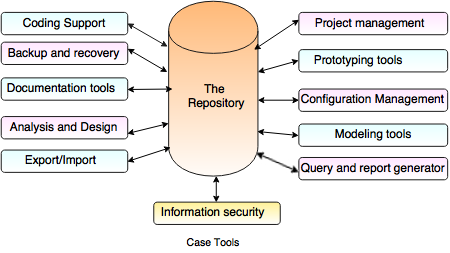Home »
Software Engineering
CASE Tools and Their Scopes in Software Engineering
In this tutorial, we will learn about the CASE tools, why do we need CASE tools, case environment, and the benefits of using CASE tools.
By Monika Sharma Last updated : April 07, 2023
What is CASE Tool?
A CASE (Computer-Aided Software Engineering) tool is a non-exclusive term used to indicate any form of automated support for software engineering. In an increasingly prohibitive sense, a CASE tool implies any tools used to automate some action related to software development. Many CASE tools are available to make software engineering development easy and efficient.
A portion of these CASE tools aid stage-related undertakings, for example, specification, structured analysis, design, testing, coding, feedback, etc. and others to non-stage exercises, for example, project management and configuration management.
Why do we need CASE tools?
The major objective of using case tools is to,
- Increase the efficiency and productivity
- To make software's cost-efficient
- To make Good Quality of software
CASE Tools: Case Environment
Individual CASE tools are valuable, the genuine intensity of a toolset can be acknowledged just when these sets of tools are incorporated into a typical system or condition. CASE tools are portrayed by the stage or phases of SDLC (software development life cycle) on which they center. Since various tools covering various stages share regular data, it is necessitated that they incorporate through a few focal repositories to have a predictable perspective on data related to the software development artifacts. This focal repository is generally an information word reference containing the meaning of all composite and basic information things. Through the focal repository, all the CASE tools in the CASE environment share normal data among themselves. Thus, a CASE situation office the automation of bit by bit techniques for programming advancement. A schematic portrayal of a CASE environment is mentioned below,

Image source: https://www.careerride.com/page/case-tools-663.aspx
Benefits of using CASE tools
There are several benefits of using Case tools and working with the case environment,
- A key advantage emerging out of the utilization of a CASE environment is cost efficiency through all software advancement stages. Various studies complete to quantify the effect of CASE put the cast decrease between 30% to 40%.
- The utilization of CASE tools prompts extensive upgrades quality. This is mainly due to the realities that one can easily emphasize through the various periods of software development and the odds of human blunder are impressively decreased.
- CASE tools help produce high caliber and steady archives. Since the significant information identifying with a product item is kept up in a focal repository, excess in the put-away information is diminished and in this way, odds of conflicting documentation are decreased.
- The presentation of a CASE environment affects the style of working of an organization and makes it situated towards the organized and methodical methodology.
- CASE tools have prompted progressive cost-efficiency in software maintenance endeavors. This emerges not just because of the huge estimation of a CASE environment in traceable errors and consistency checks, yet likewise, because of the deliberate data catch during the different periods of software development as a consequence of holding fast to a CASE environment.
Advertisement
Advertisement